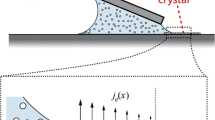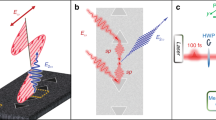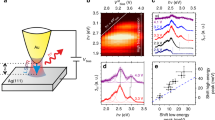Abstract
Scanning tunneling luminescence (STL) can be used to investigate the optical properties of nanostructures with high spatial resolution beyond the diffraction limit of light. To get appropriate STL spectra, one needs to modify the tip repeatedly. However, such irreversible tip modification often leads to very unstable tips. Here, by using a scanning tunneling microscope (STM) tip, we demonstrate that STL spectra are tunable via silver nanocluster arrays fabricated directly on a silver surface. The silver nanoclusters are created by transferring silver atoms from the silver tip to the silver surface under STM. We found that the STL spectra were enhanced (suppressed) at higher (lower) energy on the clusters and that they showed opposite behaviors between the nanoclusters. Without relying on the irreversible tip shape modification, our findings indicate that we can tune the STL spectra simply by moving the STM tip over the nanoclusters. Our method can be used to provide a tunable light source for systematic nano-optical experiments and for nanoscale optical devices.
Similar content being viewed by others
References
K. Kuhnke, C. Große, P. Merino and K. Kern, Chem. Rev. 117, 5174 (2017).
E. C. Neyts, K. Ostrikov, M. K. Sunkara and A. Bogaerts, Chem. Rev. 115, 13408 (2015).
Y. Zhang et al., Chem. Rev. 118, 2927 (2018).
R. Berndt, J. K. Gimzewski and P. Johansson, Phys. Rev. Lett. 67, 3796 (1991).
R. Berndt and J. K. Gimzewski, Phys. Rev. B 48, 4746 (1993).
M. Moskovits, Rev. Mod. Phys. 57, 783 (1985).
X. H. Qiu, G. V. Nazin and W. Ho, Science 299, 542 (2003).
Z. C. Dong et al., Nat. Photonics 4, 50 (2010).
R. Zhang et al., Nature 498, 82 (2013).
C. Chen, C. A. Bobisch and W. Ho, Science 325, 981 (2009).
Y. Zhang et al., Nature 531, 623 (2016).
E. Kazuma et al., Science 360, 521 (2018).
K. Kaiser, L. Gross and F. Schulz, ACS Nano 13, 6947 (2019).
C. Chen et al., Phys. Rev. Lett. 105, 217402 (2010).
C. Chen, N. Hayazawa and S. Kawata, Nat. Commun. 5, 3312 (2014).
J. Aizpurua, S. P. Apell and R. Berndt, Phys. Rev. B 62, 2065 (2000).
P. Johansson, Phys. Rev. B 58, 10823 (1998).
S. Wu and D. L. Mills, Phys. Rev. B 65, 205420 (2002).
D. L. Mills, Phys. Rev. B 65, 125419 (2002).
A. Downes, M. E. Taylor and M. E. Welland, Phys. Rev. B 57, 6706 (1998).
H. Imada et al., Phys. Rev. Lett. 119, 013901 (2017).
A. Yu, S. Li, G. Czap and W. Ho, Nano Lett. 16, 5433 (2016).
P. Myrach, N. Nilius and H. J. Freund, Phys. Rev. B 83 (2011).
R. Berndt, J. K. Gimzewski and P. Johansson, Phys. Rev. Lett. 71, 3493 (1993).
B. C. Stipe, M. A. Rezaei and W. Ho, Rev. Sci. Instrum. 70, 137 (1999).
G. Schull, T. Frederiksen, M. Brandbyge and R. Berndt, Phys. Rev. Lett. 103, 206803 (2009).
Our finding might be interpreted as wavelength-dependent spectral weight transfer. However, spectral weight transfer may not be good enough to describe the effect of nanoclusters because we could not observe the same amounts of enhancement/suppression in STL intensities at specific wavelengths from the same nanoclusters with different tips.
K. C. Tang et al., J. Am. Chem. Soc. 133, 17738 (2011).
M. Dong et al., Chem. Comm. 51, 12981 (2015).
D. Martindale and A. W. Paeth, Graphics Gems II (Academic Press, Boston, 1991).
X. Duan, S. Kamin and N. Liu, Nat. Commun. 8, 1 (2017).
X. Wang et al., ACS Appl. Mater. Interfaces 10, 1422 (2018).
Acknowledgments
This work was supported by the Institute for Basic Science (Grant No. IBS-R014-D1) and by a National Research Foundation of Korea (NRF) grant funded by the Korea government (Ministry of Science and ICT) (Grant No. 2018R1A5A6075964, 2020R1F1A1076401).
Author information
Authors and Affiliations
Corresponding authors
Rights and permissions
About this article
Cite this article
Cui, S., Kim, TH. & Ham, U. Tunable Plasmonic Quantum Light Source with Silver Nanoclusters on a Silver Surface. J. Korean Phys. Soc. 77, 133–137 (2020). https://doi.org/10.3938/jkps.77.133
Received:
Revised:
Accepted:
Published:
Issue Date:
DOI: https://doi.org/10.3938/jkps.77.133




